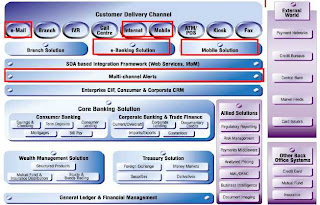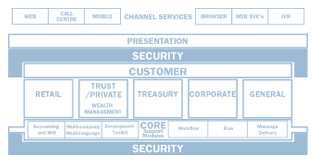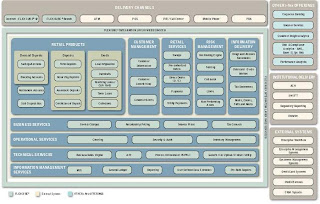You will find discussion, article, web link that are related to IT Management. The idea of article comes from direct experience working in System Integrator/Solution Provider company as well as from textbooks which are used in many Information Technology Post Graduate Study
Wednesday, December 23, 2009
Banking Innovations Forum 2009 - Bartłomiej Kozakowski, Comarch
This presentation provide a good discussion on how banking should innovate on the changes of customer doing banking which due to its different lifestyle and demands. The new technology enable bank to provide various channel to serve the customers and Web 2.0 technology will create a new way of banking service its customers
Tuesday, December 8, 2009
Business Modell Banking 2015 John White Ibm
John White brings a discussion on how banking industry will reshape and make the bank to think again their strategies. Business model innovation is key to growth and differentiation
Business Modell Banking 2015 John White Ibm
View more presentations from Fred Zimny.
Tuesday, November 17, 2009
Retail Bank's Cost Breakdown
This information is taken from Study that is done by IBM and the study is based on Bank's in Europe. However I think the information is still quite valid as customer facing activities require a lot of time which then logically contribute the higher cost percentage as well.

This information is quoted as I think many of us are looking for such information, and this sharing / discussion can be usefull.
Label:
IT Cost,
IT Management,
Performance Metrics
Monday, November 16, 2009
Business Value - Performance Metrics (2)
If Delloite defines various aspects of Shareholders value that can be increased, however to measure it we also need its metrics. Gartnerin this Research provides what they call as The Gartner Business Value Model. This model helps a business to align Business Metrics with business aspects. The Business Value Model provides metrics that we use for several dimension. While this discussion doesn't compare in detail each value in Delloite's table with each metrics however we can see a coorelation between the two models, which always link to business.


Quoted from Gartner - The Gartner Business Value Model
Gartner defines three business aspects i.e.
- Demand Management - which consist of Market and Sales Responsiveness, Product Development Effectiveness, which much related to revenue growth and operating margin
- Supply Management - which consist of customer and supplier effectiveness, and operational effiency
- Support Management - this aspect consist of Human Resources, IT and Finance & Regulatory Reponsiveness.
So using these two maps - we are much help to be more structure to understand how the business is measured and how actually each of them able give value to shareholders.
Business Value - Performance Metrics (1)
Shareholders expects returns to its business investments. The challenge is how do you define the returns terms. What are the ascpect that we can use to explain returns that businesses have created to shareholders. This is also related to how do you can generate performance metrics to provide a clear explanation about business operation result that supposed to create the returns.
To discuss this topic, two major consulting firm approach are quoted in this edition. Deloitte provide as what is called as Enterprise Value Map. This Value Map defines shareholders value into four VALUE DRIVERS cateories i.e. Revenue Growth, Operating Margin, Asset Efficiency and Expectations. This model then drill-down each value into a more detail to support the value drivers into these steps :
- Level 1 : It show areas that you can do to improve each value.
- Level 2 : It triggers us to change what we have done - which looking at what we have provide, whom is the target, how do we compete, how we do our operations.
- Level 3 : It asks you to do better in each aspect by reviewing our business processes, aligning resources with strategies, improving control/reduce risk, collaborating more effectively
This model also have another dimension about where the improvement must be done in order to achieve higher business value. There are six key business process dimension in this model i.e :
- Business Strategy and Management
- Customer Strategy, Relationships and Interactions
- Product Strategy, Development and Production
- Human Capital Strategy and Management
- IT Strategy and Management
- Other shared services
By navigating the enterprise value map by Delloite, then we can also map how we want to go about for Shareholders Value Improvement.
Wednesday, November 11, 2009
Banking Solution - Architecture
There are many areas in Banking Operation that can be improved by using the right InformationSystem Solution. Actually automation in Banking requires a very comprehensive set of solution comparing to other industries. Transactional and non transactional system in banking need support from Information System.
Having this situation, one can be much helped if he can understand the solution components that are actually can be intergrated in a bank. Several Banking Enterprise Solution providers have provided their solution architecture for us so that we are able to see in high level how each solution is interlink one and anothers. In this discussion I quoted solution architecture that is provided by SAP, Infosys, Temenos and Oracle-iflex for our reference.

Diagram 1 : SAP - Solution Map

Diagram 2 : Infosys Solution Architecture

Diagram 3 : Temenos Solution Architecture

Diagram 4 : Iflex Solution Architecture
As can be seen, that in each solution architecture - we can see that there are three major sections for the banking operation automation i.e :
- Delivery Channel
- Customer Management
- Product Management
- Financial Accounting
- Decision Support System
In each section, an IT Managers then can map their current solution and see opportunities for automation improvement to support the overall business goal.
Monday, November 9, 2009
Getting Right User Requirements
Getting the right user requirements in initial phase of software implementation is always a challenge. Poor requirements specifications can result in systems that do not meet user needs. In the most extreme case, incomplete or error-riddled requirements specifications result in both time and money wasted building the wrong system. Customer perception of past solution package, past software problems and past operation procedure often build a wrong way of providing the right business requirements. Other aspect in getting the right business requirement is also due to schedule pressure which cause oversight.
Some ways to having a better process are :
- Including Business Process Owners who runs day to day operation in the discussion
- Having a software business analyst to interview business process owners
- Understanding that business requirements might not be able capture 100% since day one, so several can be categorised as current business, new business req and potentially new requirements that are not foreseen
- Mapping requirements into software standard package features, package extentions, and non system solution such as adjustment in the system procedures
- Choosing from several System Development Life Cycle approaches which is fit for a complex implementation such as : Spiral Model, Incremental Development are found will reduce risk.
To support the above process, especially getting complete business requirements - a tool from ravenflow which help to give a visual requirement definition can be also useful to validate if you have missing requirements.
Thursday, October 29, 2009
Business Intelligence - Implementation Challenge
Gartner has done a study about Top Strategic Technology in every year, and for the 2009 and 2010, Business Intelligence has become one of that list. If you want to know, whether you have used this technology in your work or company then this discussion would be answered your question.
Business Intelligence is a generic name which in its implementation and use can be in many forms. Wikipedia defined it as to skills, technologies, applications and practices used to help a business acquire a better understanding of its commercial context. It is aimed to help business decision making process more accurate as it has some valid data to support it.
While everyone would like be able to do so, however it its real implementation that is not easy case. Several key challenges that I experienced are :
- The project is treated as technology implementation. The project must have a strong business analyst or data analyst that knows exactly the requirements
- Users have not been discipline from the start in providing the necessary data to make decision. In this case the application will not be able to do anything
- Scope is not defined well and application comes as a tool. This often create a situation where the output is not what the users are expected
- Technology issues such as sizing capacity and the selection of the tools are also need to be prepared carefully
In this discussion - you might want to know what is there in the market for you to used, and Gartner clasification of Business Intelligence Platform could be usefull.
IT Strategic Grid
There are several methods on how you can evaluate where does and IT give the company value added. One of the methods is Strategic Grid Analysis which is developed by McFarlan and McKenney. This method is explained in 'Corporate Information Systems Management : The Issues Facing Senior Executives' (1983).
The strategic grid is useful explains where and how IT investmet has been made. It clasifies IT investment into four categories :
- Strategic : Investment that is critical for future success
- Turnaround : Investment that is strategic importance and be able to provide strategic opportunities
- Factory : Invesment that is required to sustain existing business. This investment aims to improve performance or reduce cost
- Support : Investment that is necessary for improving, but not critical to existing business. Normally this much related to individual performance improvement tools
The clasification helps management to see whether IT investments so far have been aligned to business objectives such as to support business growth, competitiveness or new business venture.
The IT Strategic Grid is normally drawed by 2X2 boxes which in each quadrant the four type of IT investment is listed. This link will give you an illustration of this tools as well as some additional definition.
Sunday, September 27, 2009
Software Quality Certification
Improving your software quality will require a lot of dicipline from your programmer in executing the SDLC method that you want to apply. I found many fresh programmers often look software source code management, change management, proper documentation as the burden. These topics also do not have to be a popular subject in the college or university. I discussed with couple of programmers with average about 1.5 years experience, many of them do not know the importance of it. While now a day, solution in software development and testing is already so advance which then will 'force' programmer must follow certain rules however providing the explanation of how importance of running those routines is the key.
In regards to equip programmers, system analysts and business analysts with a structured knowledge, it is worth to have your team member certified in these several subjects. The certification is approved by a body call QAI Global Institute. It has several certifications, several of them are :
- Certified Associate in Software Quality (CASQ)
- Certified Associate in Software Testing (CAST)
- Certified Associate Business Analyst (CABA)
- Certified Software Business Analyst (CSBA)
- Certified Software Process Engineer (CSPE)
- Certified Quantitative Software Process Engineer (CQSPE)
Most of the training is done through web and tested through prometric testing center wordwide. So it is quite flexible and also the cost of training also justify for you who want to have the right source of knowledge in improving software quality.
Saturday, August 15, 2009
Challenge IT Project in Small Medium Enterprise
What would be the challenge in implementing a project in Small Medium Enterprise (SME) ? Some critical success factors in implementing a project are User / Management Support, Project Scope, Infrastructure to support the project, Business/Process Understanding of the industry, Change Management, adequate resources and Personnel Leadership by Project Management. In a Small Medium Enteprise where many of these factors often can't be provided, implementing an IT Project can be a tough job. It is often that a system integrator wants to implement a project in SME environment has taken this factor too easy which then put the project into a difficult situation.
The challenge can comes in every factors which not because the SME does not want to support the project however it is merely the capacity is not there. In that situation, a system integrator must be able to calculate the risk and find a chance to educate the SME before the project is started. It is must be overlooked because the customer size is relatively small then the project could be easier. This could be trapped that a new project manager will face.
In that situation some key suggestion including :
- Strong Project Management Leadership on both side
- Drive by the higher management can help a lot
- Find an informal leader to be the advisor of the project
- Implementing a good change management approach is important
While it looks quite familiar in many project however in SME those aspect can be even critical, because those are only the basic - minimal requirements before a project can start.
Sunday, July 26, 2009
Tools for Project Management
Managing multiple project can be very not effective if you are not supported by the right tool. Focus and prioritation of a project manager must be on the project and must not on the tool, however without the right tool you are not possible to direct your projects into the right point.
There are a lot of tools in the market now, which is offered either by SAAS model and the normal installation model. However whatever tools that you are selected it must be able to do several key tasks i.e. Project Registration, Project Portfolio and prioritation, Resource Registration, Resource Time Sheet, Project Cost and Resource Tracking, Project Plan Development.
Several solution that you can choose in the SAAS model that worth to look at is Innotas, as well as @task This project management tools is very informative as well as it has moved also to application portfolio management which overall give a complete set of IT governance tools. While for the full blown Enterprise Project Management, the recent Microsoft Enterprise Project Management is a strong strong solution that you can evaluate. This tool has been much improved from its previous version and be able to compare with Primavera Solution who has been acquired by Oracle
If you prefer to look for more SAAS type of solution, this link would be able to help you. This site give a list for all SAAS solution that you can possibly have.
Subscribe to:
Comments (Atom)